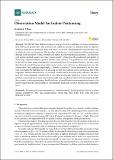| dc.contributor.author | Horn, Berthold K. P. | |
| dc.date.accessioned | 2020-09-25T19:09:19Z | |
| dc.date.available | 2020-09-25T19:09:19Z | |
| dc.date.issued | 2020-07 | |
| dc.date.submitted | 2020-05 | |
| dc.identifier.issn | 1424-8220 | |
| dc.identifier.uri | https://hdl.handle.net/1721.1/127692 | |
| dc.description.abstract | The IEEE 802.11mc WiFi standard provides a protocol for a cellphone to measure its distance from WiFi access points (APs). The position of the cellphone can then be estimated from the reported distances using known positions of the APs. There are several “multilateration” methods that work in relatively open environments. The problem is harder in a typical residence where signals pass through walls and floors. There, Bayesian cell update has shown particular promise. The Bayesian grid update method requires an “observation model” which gives the conditional probability of observing a reported distance given a known actual distance. The parameters of an observation model may be fitted using scattergrams of reported distances versus actual distance. We show here that the problem of fitting an observation model can be reduced from two dimensions to one. We further show that, perhaps surprisingly, a “double exponential” observation model fits real data well. Generating the test data involves knowing not only the positions of the APs but also that of the cellphone. Manual determination of positions can limit the scale of test data collection. We show here that “boot strapping,” using results of a Bayesian grid update method as a proxy for the actual position, can provide an accurate observation model, and a good observation model can nearly double the accuracy of indoor positioning. Finally, indoors, reported distance measurements are biased to be mostly longer than the actual distances. An attempt is made here to detect this bias and compensate for it. | en_US |
| dc.publisher | Multidisciplinary Digital Publishing Institute | en_US |
| dc.relation.isversionof | http://dx.doi.org/10.3390/s20144027 | en_US |
| dc.rights | Creative Commons Attribution | en_US |
| dc.rights.uri | https://creativecommons.org/licenses/by/4.0/ | en_US |
| dc.source | Multidisciplinary Digital Publishing Institute | en_US |
| dc.title | Observation model for indoor positioning | en_US |
| dc.type | Article | en_US |
| dc.identifier.citation | Horn, Berthold K. P. "Observation model for indoor positioning." Sensors 20, 14 (July 2020): 4027 ©2020 Author(s) | en_US |
| dc.contributor.department | Massachusetts Institute of Technology. Department of Electrical Engineering and Computer Science | en_US |
| dc.relation.journal | Sensors | en_US |
| dc.eprint.version | Final published version | en_US |
| dc.type.uri | http://purl.org/eprint/type/JournalArticle | en_US |
| eprint.status | http://purl.org/eprint/status/PeerReviewed | en_US |
| dc.date.updated | 2020-08-21T13:49:30Z | |
| dspace.date.submission | 2020-08-21T13:49:30Z | |
| mit.journal.volume | 20 | en_US |
| mit.journal.issue | 14 | en_US |
| mit.license | PUBLISHER_CC | |
| mit.metadata.status | Complete | |
